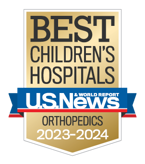Gymnast Wrist

Gymnast wrist (distal radial epiphysitis) is a term used to describe an overuse injury involving the growth plate of the radius (the forearm bone that connects to the wrist). This overuse has been described as a stress reaction (irritation or inflammation) or stress fracture (widening or associated bony changes) of the growth plate.
Causes
Gymnast wrist results from repetitive stress through the growth plate caused by excessive weight bearing or impact activities.
Symptoms
Pain is the most common symptom associated with gymnast wrist. This pain is often located over the thumb side of the wrist. The pain is commonly worse during impact or weight-bearing activities, but it may also be present while at rest. The athlete may develop mild swelling and/or may notice pain or a decrease in the movement of the wrist.
Diagnosis
The health care provider will review the history of the athlete’s wrist pain and complete a thorough physical exam of the affected arm and wrist.
X-rays are often used to assess the bones of the wrist and forearm. In the early stages of the injury, X-rays may be negative. In later stages of the injury X-rays may show widening of the growth plate or changes within the bone near the growth plate. Advanced imaging is not commonly necessary in the diagnosis of gymnast wrist.
Treatment
Treatment involves rest from weight-bearing and impact activities. Splints and casts are generally not necessary. The duration of rest from these activities varies depending on the severity of the injury. A general timeline is below:
Initial stage (0-4 weeks)
A period of rest is the first treatment utilized with gymnast wrist. The physician will advise a period of rest ranging from a few weeks to a few months depending on the severity of the injury.
During the rest period, the physician may prescribe physical therapy to maintain mobility and upper extremity strength so as to not cause further compensation in other regions which could cause weakness to surrounding muscles, abnormal movement patterns or loss in joint mobility. The physical therapist will initially begin with gentle range of motion exercises to maintain correct motion and movement to the affected joint. Next, the therapist will introduce light strengthening exercises that address the hand, wrist, elbow, shoulder and even shoulder blades. It is important that the entire upper extremity kinetic chain be addressed so once the athlete is ready to return to sports, they are not lacking adequate stability to the non-injured areas.
Intermediate stage (4-8 weeks)
As the patient regains full mobility and continues to work on strengthening, the PT will slowly progress weight bearing through the involved hand and wrist. Putting some weight through the hand will not slow healing time or create more damage. The activities that will be performed are controlled weight bearing without impact (such as wall pushups) and therefore, not harmful to the injured area.
Final stage (8-12 weeks)
Once cleared by the physician to begin return to sports, the PT will begin incorporating full-body, weight-bearing exercises as long as symptoms do not return (i.e. push-ups to handstands to back handsprings). The exercise progression will largely depend on the skill of the athlete but ultimately is focused on the ability to correctly maintain bodyweight plus impact without loss in stability or return of symptoms. As the athlete is able to progress in therapy, they will simultaneously begin a return to participation outside of therapy that may take 2-4 weeks.
Find Children’s Mercy Sports Medicine on social media
- Injury Management
- Ankle Injuries
- Athletic Training
- Concussion Treatment
- Gymnast Wrist
- Hockey Injuries
- Human Performance Lab
- Mental Wellness
- Meet the Sports Medicine Team
- Osteochondritis Dissecans (OCD)
- Patella Tendonitis (Jumper’s Knee)
- Patellofemoral Pain Syndrome (Runner’s Knee)
- Sports Medicine Center
- Sports Physical Therapy
- 360° Tour of Village West



